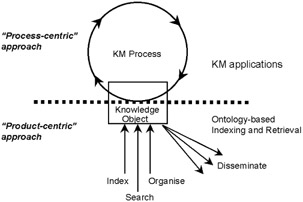Conceptual Foundation of the Approach
The focus of this chapter is not on what knowledge is; rather it is on what knowledge can do. Hence for the purpose of having a definition of knowledge, we extend a definition given by Nonaka (1991): "Knowledge is justified belief that increases an entity's capacity for effective action."
Our definition of knowledge is: The ideas, or understandings, which an entity possesses that are used to take effective action to achieve the entity's goal(s). Our focal point is the business domain, and we examine individuals, teams, organizations, and inter-organizational settings (e.g., virtual enterprises) as entity types that leverage knowledge to create business goals and achieve commercial values.
We consider knowledge management to be a new discipline of enabling individuals, teams, and entire organizations to collectively and systematically create, share, and apply corporate knowledge assets to better achieve organizational efficiency, responsiveness, competency, and innovation.
Knowledge management encompasses the identification and mapping of knowledge assets within the organization, the generation of new knowledge assets for competitive advantage, making knowledge assets accessible and sharing them across an organization.
Our framework tackles the fact that knowledge management should be implemented as an ongoing business task with two primary aspects:
-
treating the knowledge component of business performance, reflected in strategy, processes, structure, and systems at all levels of the organization; and
-
making a direct connection between the organizational knowledge assets—both explicit and tacit—and improved business performance.
From a conceptual abstract point of view, for the integration of the process and product views, we follow the work of Cook and Seely Brown (1999), who strive to explain how knowledge is connected to the actions of individuals and groups. Their concept of knowing, i.e., putting knowledge into practice, is close to our concept of knowledge as a process. Cook and Seely Brown (1999) call it: "what is 'possessed' knowledge and what is part of action 'knowing'" (p. 383).
In other words knowing is putting knowledge in practice while knowledge is knowing at rest. They admit that "this does not mean that knowledge of abstract concepts and principles is useless to action, only that it is not the same as enacting the skills associated with it" (p. 19). Cook and Seely Brown (1999) also add that knowledge itself does not underlie or enable knowing, just as having a hammer may not mean one knows how to use it.
In this way we may introduce a static ("knowledge as a product") mode, and a dynamic ("knowledge as a process") mode in knowledge management. Knowledge represents the static mode, as what we possess we do not always use, and knowing is the dynamic mode, as it is representing a concrete, dynamic human action and it focuses on the interactions with the social and physical world.
We are interested both in managing the "stock" of knowledge (that covers the "knowledge as an object" approach) and the "flow" of knowledge (that addresses the "knowledge as a process" approach) within the organization (see Figure 1).

Figure 1: Knowledge Asset Management Fuses the Product- and Process-Centric Approaches
Our perspective is that knowledge assets can be human—such as a person or a network of people; structural—such as a business process; or market—such as a brand name of a product. Naturally the product-centric approach is more concerned with accessing and organizing knowledge assets, while the process approach makes direct connections between the organizational knowledge assets—both explicit and tacit. Both approaches however are using some form of knowledge representation as a means of packaging and transferring knowledge either from a person to a system and vice versa or between people.
If we define knowledge objects as the means of representing knowledge, then the following statement outlines the relation between knowledge assets and knowledge objects: A knowledge asset creates, stores, and/or disseminates knowledge objects.
For example:
-
a person is a knowledge asset that can create new ideas, teachings, proposals, and white papers (knowledge objects);
-
a community of interest is a knowledge asset that can create new ideas and best practices (knowledge objects);
-
a process is a knowledge asset that can create and/or store and disseminate best practices, company standards, and R&D material (knowledge objects);
-
a vision is a knowledge asset that can create a new mission statement, strategic plan, and goals (knowledge objects).
A knowledge objects represent the information required to be processed by humans and transformed into knowledge (see Figure 2). Knowledge derives from information through knowledge-creating activities that take place within and between humans. Typical knowledge-creating activities include (see, e.g., Davenport & Prusak, 1998):
-
Comparison: how does information about this situation compares to other situations known?
-
Consequences: what implications does the information have for decision and actions?
-
Connections: how does this bit of knowledge relate to others?
-
Conversation: what do other people think about this information?

Figure 2: Knowledge Assets and Knowledge Objects
The knowledge objects aim to facilitate and leverage such knowledge-creating activities by providing to humans the information need. A knowledge object has the following characteristics:
-
It acts as a catalyst, enabling the fusion of knowledge flows between people, with knowledge content discovery and retrieval, through technology. That is to say, a knowledge object acts, among other things, as the primary connecting node for all key components in a KM system (strategy, people, process, content, technology)—'the KM glue'.
-
It facilitates the knowledge transfer from person to person, or from information to person.
-
A knowledge object is created and maintained by a KM process.
-
A knowledge object is used to search, organize, and disseminate knowledge content.
We conclude that the knowledge assets and knowledge objects are the common unifiers of the knowledge asset framework that incorporates and integrates process and content. We have used these concepts as the 'resultant manifestation' in the design of a KM solution that fuses the process-centric approach with the product-centric approach that is further examined in the next section.
EAN: 2147483647
Pages: 198